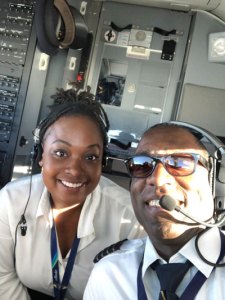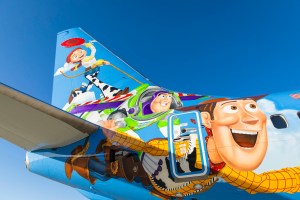Hawaiian Holdings Reports 2019 Third Quarter Financial Results
Share

HONOLULU — Hawaiian Holdings, Inc. (NASDAQ: HA) (the “Company”), parent company of Hawaiian Airlines, Inc. (“Hawaiian”), today reported its financial results for the third quarter of 2019.
|
Third Quarter 2019 – Key Financial Metrics |
||||||||
|
|
|
GAAP |
|
YoY Change |
|
Adjusted |
|
YoY Change |
|
Net Income |
|
$80.1M |
|
($13.5M) |
|
$81.5M |
|
($15.2M) |
|
Diluted EPS |
|
$1.70 |
|
($0.14) |
|
$1.72 |
|
($0.19) |
|
Pre-tax Margin |
|
14.4% |
|
(1.0) pts. |
|
14.6% |
|
(1.3) pts. |
“Our team did a fantastic job this quarter, demonstrating once again that Hawaiian Airlines is the carrier of choice for guests traveling to, from and within the Hawaiian Islands,” said Peter Ingram, Hawaiian Airlines president and CEO. “In the face of heightened competition, we delivered strong financial results and made significant progress towards accomplishing the strategic priorities that we established at the beginning of the year. As we enter the home stretch of 2019, we look forward to continuing to execute our proven formula for generating value for our guests and our investors. I extend my thanks, as always, to my 7,300 colleagues for their tireless efforts to deliver award-winning, authentic Hawaiian hospitality every day.”
Statistical information, as well as a reconciliation of the non-GAAP financial measures, can be found in the accompanying tables.
Shareholder Returns, Liquidity and Capital Resources
The Company returned $25.7 million to shareholders in the third quarter through share repurchases of $20.0 million and a dividend payment of $5.7 million.
On October 18, 2019, the Company's Board of Directors declared a quarterly cash dividend of 12 cents per share to be paid on November 29, 2019 to all shareholders of record as of November 15, 2019.
As of September 30, 2019, the Company had:
• Unrestricted cash, cash equivalents and short-term investments of $745 million
• Outstanding debt and finance lease obligations of $782 million
Third Quarter 2019 Highlights
Leadership and People
• Appointed Robin Kobayashi as interim Senior Vice President of Human Resources.
Operational
• Ranked #1 nationally for on-time performance year-to-date through August 2019, as reported in the U.S. Department of Transportation Air Travel Consumer Report, adding to its record of 15 consecutive years as the most punctual airline.
• Implemented Amadeus’ Departure Control Flight Management to optimize load planning and improve operational efficiency.
Products and Services
• In September and October, launched sales of Main Cabin Basic fares in all North American markets, enhancing Hawaiian's product portfolio with a fare option that appeals to the most price-conscious travelers.
Routes and Network
• Received final U.S. Department of Transportation approval to operate one additional daily nonstop flight between Tokyo Haneda Airport (HND) and Honolulu Daniel K. Inouye International Airport (HNL) starting in March of 2020.
• Announced service for three new routes with its A321neo fleet:
◦ Four-times-weekly service between Maui’s Kahului Airport (OGG) and Las Vegas’ McCarran International Airport (LAS) beginning December 15, 2019
◦ Thrice-weekly nonstop service between Honolulu (HNL) and Seattle-Tacoma International Airport (SEA) starting January 7, 2020, supplementing existing daily A330-200 service
◦ Seasonal winter service between Maui (OGG) and Los Angeles International Airport (LAX) from December 14, 2019 through January 5, 2020, supplementing existing daily A330-200 service
Fleet & Financing
• Took delivery of two Airbus A321neo aircraft, increasing the size of its A321neo fleet to fifteen aircraft.
• Entered into two Japanese Yen-denominated debt financings, collateralized by four Airbus A330 aircraft and two Airbus A321neo aircraft.
• Extended the leases on three A330 aircraft, enabling cost savings while maintaining fleet flexibility for future growth.
Fourth Quarter and Full Year 2019 Outlook
The table below summarizes the Company’s expectations for the fourth quarter ending December 31, 2019, and the full year ending December 31, 2019, expressed as an expected percentage change compared to the results for the quarter and the full year ended December 31, 2018, as applicable.
|
|
|
Fourth Quarter |
|
|
|
GAAP Fourth Quarter |
|
Item |
|
2019 Guidance |
|
GAAP Equivalent |
|
2019 Guidance |
|
ASMs |
|
Up 3.0 – 4.5% |
|
|
|
|
|
Operating revenue per ASM |
|
Down 0.5 – 3.5% |
|
|
|
|
|
Cost per ASM excluding fuel and non-recurring items (a) |
|
Up 0.5 – 3.5% |
|
Cost per ASM (a) |
|
Down 0.1 – 2.5% |
|
Gallons of jet fuel consumed |
|
Up 0.5 – 2.5% |
|
|
|
|
|
Economic fuel cost per gallon (b)(c) |
|
$2.02 |
|
Fuel cost per gallon (b) |
|
$1.98 |
|
|
|
Full Year |
|
|
|
GAAP Full Year |
|
Item |
|
2019 Guidance |
|
GAAP Equivalent |
|
2019 Guidance |
|
ASMs |
|
Up 1.9 – 2.4% |
|
|
|
|
|
Cost per ASM excluding fuel and non-recurring items (a) |
|
Up 1.8 – 2.6% |
|
Cost per ASM (a) |
|
Down 2.3 – 2.9% |
|
Gallons of jet fuel consumed |
|
Down 1.0 – 1.5% |
|
|
|
|
|
Economic fuel cost per gallon (b)(c) |
|
$2.05 |
|
Fuel cost per gallon (b) |
|
$2.00 |
(a) See Table 4 for a reconciliation of GAAP operating expenses to operating expenses excluding aircraft fuel and non-recurring items.
(b) Fuel cost per gallon estimates are based on the October 10, 2019 fuel forward curve.
(c) See Table 3 for a reconciliation of GAAP fuel costs to economic fuel costs.
Investor Conference Call
Hawaiian Holdings’ quarterly earnings conference call is scheduled to begin today (October 22, 2019) at 4:30 p.m. Eastern Time (USA). The conference call will be broadcast live over the Internet. Investors may access and listen to the live audio webcast on the investor relations section of the Company’s website at HawaiianAirlines.com. For those who are not available for the live webcast, a replay of the webcast will be archived for 90 days on the investor relations section of the Company's website.
About Hawaiian Airlines
Hawaiian® has led all U.S. carriers in on-time performance for each of the past 15 years (2004-2018) as reported by the U.S. Department of Transportation. Consumer surveys by Condé Nast Traveler, Travel + Leisure and TripAdvisor have placed Hawaiian among the top of all domestic airlines serving Hawai‘i.
Now in its 90th year of continuous service, Hawaiian is Hawai‘i’s biggest and longest-serving airline. Hawaiian offers non-stop service to Hawai‘i from more U.S. gateway cities (13) than any other airline, along with service from Japan, South Korea, Australia, New Zealand, American Samoa and Tahiti. Hawaiian also provides, on average, more than 170 jet flights daily between the Hawaiian Islands, with a total of more than 260 daily flights system-wide.
Hawaiian Airlines, Inc. is a subsidiary of Hawaiian Holdings, Inc. (NASDAQ: HA). Additional information is available at HawaiianAirlines.com. Follow Hawaiian's Twitter updates (@HawaiianAir), become a fan on Facebook (Hawaiian Airlines), and follow us on Instagram (hawaiianairlines). For career postings and updates, follow Hawaiian's LinkedIn page.
For media inquiries, please visit Hawaiian Airlines' online newsroom.
Forward-Looking Statements
This press release contains “forward-looking statements” within the meaning of the Private Securities Litigation Reform Act of 1995 that reflect the Company’s current views with respect to certain current and future events and financial performance. Such forward-looking statements include, without limitation, the Company’s expectations regarding available seat miles, cost per available seat mile, cost per available seat mile excluding fuel and non-recurring items, gallons of jet fuel consumed, fuel cost per gallon, and economic fuel cost per gallon for the quarter and full year ending December 31, 2019; the Company's expectations regarding operating revenue per available seat mile for the quarter ending December 31, 2019; and statements as to other matters that do not relate strictly to historical facts or statements of assumptions underlying any of the foregoing. Words such as “expects,” “anticipates,” “projects,” “intends,” “plans,” “believes,” “estimates,” variations of such words, and similar expressions are also intended to identify such forward-looking statements. These forward-looking statements are and will be subject to many risks, uncertainties and assumptions relating to the Company’s operations and business environment, all of which may cause the Company’s actual results to be materially different from any future results, expressed or implied, in these forward-looking statements. These risks and uncertainties include, without limitation, the Company’s ability to accurately forecast quarterly and annual results; economic volatility; macroeconomic developments; political developments; the price and availability of aircraft fuel; fluctuations in demand for transportation in the markets in which the Company operates, including due to the occurrence of natural disasters such as hurricanes, earthquakes and tsunamis; the Company’s dependence on tourist travel; labor negotiations; regulatory determinations and related developments; competitive pressures, including the impact of rising industry capacity between North America and Hawai‘i and interisland; the Company's ability to continue to generate sufficient cash flow to support the payment of a quarterly dividend; changes in the Company's future capital needs; foreign currency exchange rate fluctuations; and the Company’s ability to implement its growth strategy.
The risks, uncertainties and assumptions referred to above that could cause the Company’s results to differ materially from the results expressed or implied by such forward-looking statements also include the risks, uncertainties and assumptions discussed from time to time in the Company’s other public filings and public announcements, including the Company’s Annual Report on Form 10-K and the Company’s Quarterly Reports on Form 10-Q, as well as other documents that may be filed by the Company from time to time with the Securities and Exchange Commission. All forward-looking statements included in this document are based on information available to the Company on the date hereof. The Company does not undertake to publicly update or revise any forward-looking statements to reflect events or circumstances that may arise after the date hereof even if experience or future changes make it clear that any projected results expressed or implied herein will not be realized.
Hawaiian Holdings, Inc.
Consolidated Statements of Operations (unaudited)
|
|
|
Three Months Ended September 30, |
|
Nine Months Ended September 30, |
||||||||||||||||||
|
|
|
2019 |
|
2018 |
|
% Change |
|
2019 |
|
2018 |
|
% Change |
||||||||||
|
|
|
(in thousands, except per share data) |
||||||||||||||||||||
|
Operating Revenue: |
|
|
|
|
|
|
|
|
|
|
|
|
||||||||||
|
Passenger |
|
$ |
694,263 |
|
|
$ |
697,232 |
|
|
(0.4 |
)% |
|
$ |
1,948,990 |
|
|
$ |
1,963,994 |
|
|
(0.8 |
)% |
|
Other |
|
60,888 |
|
|
61,855 |
|
|
(1.6 |
)% |
|
175,101 |
|
|
175,952 |
|
|
(0.5 |
)% |
||||
|
Total |
|
755,151 |
|
|
759,087 |
|
|
(0.5 |
)% |
|
2,124,091 |
|
|
2,139,946 |
|
|
(0.7 |
)% |
||||
|
Operating Expenses: |
|
|
|
|
|
|
|
|
|
|
|
|
||||||||||
|
Wages and benefits |
|
182,862 |
|
|
176,642 |
|
|
3.5 |
% |
|
537,997 |
|
|
516,906 |
|
|
4.1 |
% |
||||
|
Aircraft fuel, including taxes and delivery |
|
138,586 |
|
|
162,932 |
|
|
(14.9 |
)% |
|
405,290 |
|
|
449,404 |
|
|
(9.8 |
)% |
||||
|
Maintenance, materials and repairs |
|
61,363 |
|
|
57,118 |
|
|
7.4 |
% |
|
182,539 |
|
|
176,229 |
|
|
3.6 |
% |
||||
|
Aircraft and passenger servicing |
|
41,762 |
|
|
42,063 |
|
|
(0.7 |
)% |
|
120,303 |
|
|
117,207 |
|
|
2.6 |
% |
||||
|
Depreciation and amortization |
|
41,596 |
|
|
36,373 |
|
|
14.4 |
% |
|
119,274 |
|
|
101,537 |
|
|
17.5 |
% |
||||
|
Commissions and other selling |
|
33,291 |
|
|
32,704 |
|
|
1.8 |
% |
|
96,598 |
|
|
96,482 |
|
|
0.1 |
% |
||||
|
Aircraft rent |
|
30,534 |
|
|
31,768 |
|
|
(3.9 |
)% |
|
91,773 |
|
|
93,533 |
|
|
(1.9 |
)% |
||||
|
Other rentals and landing fees |
|
33,345 |
|
|
33,227 |
|
|
0.4 |
% |
|
95,777 |
|
|
95,226 |
|
|
0.6 |
% |
||||
|
Purchased services |
|
33,120 |
|
|
32,509 |
|
|
1.9 |
% |
|
98,306 |
|
|
95,104 |
|
|
3.4 |
% |
||||
|
Contract terminations expense |
|
— |
|
|
— |
|
|
— |
% |
|
— |
|
|
35,322 |
|
|
(100.0 |
)% |
||||
|
Other |
|
42,056 |
|
|
37,925 |
|
|
10.9 |
% |
|
118,041 |
|
|
117,977 |
|
|
0.1 |
% |
||||
|
Total |
|
638,515 |
|
|
643,261 |
|
|
(0.7 |
)% |
|
1,865,898 |
|
|
1,894,927 |
|
|
(1.5 |
)% |
||||
|
Operating Income |
|
116,636 |
|
|
115,826 |
|
|
0.7 |
% |
|
258,193 |
|
|
245,019 |
|
|
5.4 |
% |
||||
|
Nonoperating Income (Expense): |
|
|
|
|
|
|
|
|
|
|
|
|
||||||||||
|
Interest expense and amortization of debt discounts and issuance costs |
|
(6,438 |
) |
|
(8,446 |
) |
|
|
|
(21,268 |
) |
|
(24,628 |
) |
|
|
||||||
|
Interest income |
|
3,148 |
|
|
3,124 |
|
|
|
|
9,205 |
|
|
6,529 |
|
|
|
||||||
|
Capitalized interest |
|
1,171 |
|
|
1,821 |
|
|
|
|
3,713 |
|
|
6,414 |
|
|
|
||||||
|
Gains (losses) on fuel derivatives |
|
(4,553 |
) |
|
3,495 |
|
|
|
|
(7,203 |
) |
|
27,064 |
|
|
|
||||||
|
Other, net |
|
(1,445 |
) |
|
937 |
|
|
|
|
(5,553 |
) |
|
(759 |
) |
|
|
||||||
|
Total |
|
(8,117 |
) |
|
931 |
|
|
|
|
(21,106 |
) |
|
14,620 |
|
|
|
||||||
|
Income Before Income Taxes |
|
108,519 |
|
|
116,757 |
|
|
|
|
237,087 |
|
|
259,639 |
|
|
|
||||||
|
Income tax expense |
|
28,443 |
|
|
23,215 |
|
|
|
|
62,820 |
|
|
58,075 |
|
|
|
||||||
|
Net Income |
|
$ |
80,076 |
|
|
$ |
93,542 |
|
|
|
|
$ |
174,267 |
|
|
$ |
201,564 |
|
|
|
||
|
Net Income Per Common Stock Share: |
|
|
|
|
|
|
|
|
|
|
|
|
||||||||||
|
Basic |
|
$ |
1.70 |
|
|
$ |
1.85 |
|
|
|
|
$ |
3.65 |
|
|
$ |
3.97 |
|
|
|
||
|
Diluted |
|
$ |
1.70 |
|
|
$ |
1.84 |
|
|
|
|
$ |
3.64 |
|
|
$ |
3.96 |
|
|
|
||
|
Weighted Average Number of Common Stock Shares Outstanding: |
|
|
|
|
|
|
|
|
|
|
|
|
||||||||||
|
Basic |
|
47,119 |
|
|
50,594 |
|
|
|
|
47,784 |
|
|
50,807 |
|
|
|
||||||
|
Diluted |
|
47,236 |
|
|
50,731 |
|
|
|
|
47,847 |
|
|
50,935 |
|
|
|
||||||
Hawaiian Holdings, Inc.
Selected Statistical Data (unaudited)
|
|
|
Three months ended September 30, |
|
Nine months ended September 30, |
||||||||||||||||||
|
|
|
2019 |
|
2018 |
|
% Change |
|
2019 |
|
2018 |
|
% Change |
||||||||||
|
|
|
(in thousands, except as otherwise indicated) |
||||||||||||||||||||
|
Scheduled Operations (a) : |
|
|
|
|
|
|
|
|
|
|
|
|
||||||||||
|
Revenue passengers flown |
|
3,066 |
|
|
3,035 |
|
|
1.0 |
% |
|
8,843 |
|
|
8,943 |
|
|
(1.1 |
)% |
||||
|
Revenue passenger miles (RPM) |
|
4,673,734 |
|
|
4,554,393 |
|
|
2.6 |
% |
|
13,288,823 |
|
|
12,918,174 |
|
|
2.9 |
% |
||||
|
Available seat miles (ASM) |
|
5,321,812 |
|
|
5,347,156 |
|
|
(0.5 |
)% |
|
15,325,559 |
|
|
15,098,431 |
|
|
1.5 |
% |
||||
|
Passenger revenue per RPM (Yield) |
|
14.85 |
¢ |
|
15.31 |
¢ |
|
(3.0 |
)% |
|
14.67 |
¢ |
|
15.20 |
¢ |
|
(3.5 |
)% |
||||
|
Passenger load factor (RPM/ASM) |
|
87.8 |
% |
|
85.2 |
% |
|
2.6 |
pt. |
|
86.7 |
% |
|
85.6 |
% |
|
1.1 |
pt. |
||||
|
Passenger revenue per ASM (PRASM) |
|
13.05 |
¢ |
|
13.04 |
¢ |
|
0.1 |
% |
|
12.72 |
¢ |
|
13.01 |
¢ |
|
(2.2 |
)% |
||||
|
Total Operations (a) : |
|
|
|
|
|
|
|
|
|
|
|
|
||||||||||
|
Revenue passengers flown |
|
3,072 |
|
|
3,039 |
|
|
1.1 |
% |
|
8,853 |
|
|
8,949 |
|
|
(1.1 |
)% |
||||
|
Revenue passenger miles (RPM) |
|
4,679,632 |
|
|
4,557,706 |
|
|
2.7 |
% |
|
13,300,090 |
|
|
12,921,666 |
|
|
2.9 |
% |
||||
|
Available seat miles (ASM) |
|
5,331,914 |
|
|
5,352,976 |
|
|
(0.4 |
)% |
|
15,341,510 |
|
|
15,104,500 |
|
|
1.6 |
% |
||||
|
Operating revenue per ASM (RASM) |
|
14.16 |
¢ |
|
14.18 |
¢ |
|
(0.1 |
)% |
|
13.85 |
¢ |
|
14.17 |
¢ |
|
(2.3 |
)% |
||||
|
Operating cost per ASM (CASM) |
|
11.98 |
¢ |
|
12.02 |
¢ |
|
(0.3 |
)% |
|
12.16 |
¢ |
|
12.55 |
¢ |
|
(3.1 |
)% |
||||
|
CASM excluding aircraft fuel and non-recurring items (b) |
|
9.38 |
¢ |
|
8.94 |
¢ |
|
4.9 |
% |
|
9.53 |
¢ |
|
9.32 |
¢ |
|
2.3 |
% |
||||
|
Aircraft fuel expense per ASM (c) |
|
2.60 |
¢ |
|
3.05 |
¢ |
|
(14.8 |
)% |
|
2.64 |
¢ |
|
2.98 |
¢ |
|
(11.4 |
)% |
||||
|
Revenue block hours operated |
|
56,088 |
|
|
55,147 |
|
|
1.7 |
% |
|
162,556 |
|
|
155,369 |
|
|
4.6 |
% |
||||
|
Gallons of jet fuel consumed |
|
69,749 |
|
|
72,133 |
|
|
(3.3 |
)% |
|
201,547 |
|
|
206,032 |
|
|
(2.2 |
)% |
||||
|
Average cost per gallon of jet fuel (actual) (c) |
|
$ |
1.99 |
|
|
$ |
2.26 |
|
|
(11.9 |
)% |
|
$ |
2.01 |
|
|
$ |
2.18 |
|
|
(7.8 |
)% |
|
Economic fuel cost per gallon (c)(d) |
|
$ |
2.04 |
|
|
$ |
2.15 |
|
|
(5.1 |
)% |
|
$ |
2.06 |
|
|
$ |
2.06 |
|
|
— |
% |
(a) Includes the operations of the Company's contract carrier under a capacity purchase agreement.
(b) See Table 4 for a reconciliation of GAAP operating expenses to operating expenses excluding aircraft fuel and non-recurring items.
(c) Includes applicable taxes and fees.
(d) See Table 3 for a reconciliation of GAAP fuel costs to economic fuel costs.
Hawaiian Holdings, Inc.
Economic Fuel Expense (unaudited)
The Company believes that economic fuel expense is a good measure of the effect of fuel prices on its business as it most closely approximates the net cash outflow associated with the purchase of fuel for its operations in a period. The Company defines economic fuel expense as GAAP fuel expense plus losses/(gains) realized through actual cash (receipts)/payments received from or paid to hedge counterparties for fuel hedge derivative contracts settled during the period.
|
|
|
Three months ended September 30, |
|
Nine months ended September 30, |
||||||||||||||||||
|
|
|
2019 |
|
2018 |
|
% Change |
|
2019 |
|
2018 |
|
% Change |
||||||||||
|
|
|
(in thousands, except per-gallon amounts) |
||||||||||||||||||||
|
Aircraft fuel expense, including taxes and delivery |
|
$ |
138,586 |
|
|
$ |
162,932 |
|
|
(14.9 |
)% |
|
$ |
405,290 |
|
|
$ |
449,404 |
|
|
(9.8 |
)% |
|
Realized losses (gains) on settlement of fuel derivative contracts |
|
3,399 |
|
|
(8,085 |
) |
|
NM |
|
9,294 |
|
|
(24,572 |
) |
|
NM |
||||||
|
Economic fuel expense |
|
$ |
141,985 |
|
|
$ |
154,847 |
|
|
(8.3 |
)% |
|
$ |
414,584 |
|
|
$ |
424,832 |
|
|
(2.4 |
)% |
|
Fuel gallons consumed |
|
69,749 |
|
|
72,133 |
|
|
(3.3 |
)% |
|
201,547 |
|
|
206,032 |
|
|
(2.2 |
)% |
||||
|
Economic fuel costs per gallon |
|
$ |
2.04 |
|
|
$ |
2.15 |
|
|
(5.1 |
)% |
|
$ |
2.06 |
|
|
$ |
2.06 |
|
|
— |
% |
|
|
|
Estimated three months ending December 31, 2019 |
|
Estimated full year ending December 31, 2019 |
||||||||||||
|
|
|
(in thousands, except per-gallon amounts) |
||||||||||||||
|
Aircraft fuel expense, including taxes and delivery |
|
$ |
134,541 |
|
to |
$ |
137,278 |
|
|
$ |
539,836 |
|
to |
$ |
542,642 |
|
|
Realized losses (gains) on settlement of fuel derivative contracts |
|
3,000 |
|
to |
3,000 |
|
|
13,000 |
|
to |
13,000 |
|
||||
|
Economic fuel expense |
|
$ |
137,541 |
|
to |
$ |
140,278 |
|
|
$ |
552,836 |
|
to |
$ |
555,642 |
|
|
Fuel gallons consumed |
|
68,089 |
|
to |
69,444 |
|
|
269,676 |
|
to |
271,045 |
|
||||
|
Economic fuel costs per gallon |
|
$ |
2.02 |
|
to |
$ |
2.02 |
|
|
$ |
2.05 |
|
to |
$ |
2.05 |
|
Table 4.
Hawaiian Holdings, Inc.
Non-GAAP Financial Reconciliation (unaudited)
The Company evaluates its financial performance utilizing various GAAP and non-GAAP financial measures, including net income, diluted net income per share, CASM, PRASM, RASM, Passenger Revenue per RPM and EBITDAR. Pursuant to Regulation G, the Company has included the following reconciliation of reported non-GAAP financial measures to comparable financial measures reported on a GAAP basis. The adjustments are described below:
• Changes in fair value of derivative contracts, net of tax, are based on market prices for open contracts as of the end of the reporting period. This line item includes the unrealized amounts of fuel derivatives (not designated as hedges) that will settle in future periods and the reversal of prior period unrealized amounts.
• Unrealized loss (gain) on foreign debt is based on fluctuations in foreign exchange rates related to foreign-denominated debt agreements.
• During the nine months ended September 30, 2019, the Company recorded a gain on disposal of Boeing 767-300 aircraft equipment of $1.9 million in conjunction with the retirement of its Boeing 767-300 fleet. During the three and nine months ended September 30, 2018, we also recorded a loss on the sale of two Boeing 767-300 aircraft covered under a forward sale agreement of $1.8 million.
The Company believes that excluding the impact of these derivative adjustments, fluctuations in foreign exchange rates, and the sale of aircraft and aircraft equipment helps investors better analyze the Company's operational performance and compare its results to other airlines in the periods presented.
2018 contract terminations expense
• During the nine months ended September 30, 2018, the Company terminated two contracts which resulted in a $35.3 million contract terminations expense. In February 2018, the Company exercised its right to terminate its purchase agreement with Airbus for six Airbus A330-800neo aircraft and the purchase rights for an additional six Airbus A330-800neo aircraft. The Company recorded a contract terminations expense to reflect a portion of the termination penalty. In January 2018, the Company entered into a transaction with its lessor to early terminate three Boeing 767-300 aircraft leases and concurrently entered into a forward sale agreement for the same three Boeing 767-300 aircraft, including two Pratt & Whitney 4060 engines for each aircraft. These aircraft were previously accounted for as operating leases. In order to exit the leases and purchase the aircraft, the Company agreed to pay a total of $67.1 million (net of all deposits) of which a portion, $35.3 million, was expensed immediately and recognized as a lease termination fee. The expensed amount represents the total purchase price over fair value of the aircraft purchased as of the date of the transaction.
|
|
|
Three months ended September 30, |
|
Nine months ended September 30, |
|||||||||||||||||||||||||||||||||||||||||||
|
|
|
2019 |
|
2018 |
|
2019 |
|
2018 |
|||||||||||||||||||||||||||||||||||||||
|
|
|
Total |
|
Diluted Per Share |
|
Total |
|
Diluted Per Share |
|
Total |
|
Diluted Per Share |
|
Total |
|
Diluted Per Share |
|||||||||||||||||||||||||||||||
|
|
|
(in thousands, except per share data) |
|||||||||||||||||||||||||||||||||||||||||||||
|
GAAP Net Income, as reported |
|
$ |
80,076 |
|
|
$ |
1.70 |
|
|
$ |
93,542 |
|
|
$ |
1.84 |
|
|
$ |
174,267 |
|
|
$ |
3.64 |
|
|
$ |
201,564 |
|
|
$ |
3.96 |
|
|||||||||||||||
|
Add (deduct): changes in fair value of derivative contracts |
|
1,154 |
|
|
0.02 |
|
|
4,590 |
|
|
0.09 |
|
|
(2,091 |
) |
|
(0.04 |
) |
|
(2,492 |
) |
|
(0.05 |
) |
|||||||||||||||||||||||
|
Add: unrealized loss (gain) on foreign debt |
|
717 |
|
|
0.01 |
|
|
(2,267 |
) |
|
(0.04 |
) |
|
2,254 |
|
|
0.05 |
|
|
(2,331 |
) |
|
(0.05 |
) |
|||||||||||||||||||||||
|
Add: loss (gain) on sale of aircraft and equipment |
|
— |
|
|
— |
|
|
1,844 |
|
|
0.04 |
|
|
(1,948 |
) |
|
(0.04 |
) |
|
1,844 |
|
|
0.04 |
|
|||||||||||||||||||||||
|
Add: contract terminations expense |
|
— |
|
|
— |
|
|
— |
|
|
— |
|
|
— |
|
|
— |
|
|
35,322 |
|
|
0.69 |
|
|||||||||||||||||||||||
|
Deduct: tax effect of adjustments |
|
(490 |
) |
|
(0.01 |
) |
|
(1,042 |
) |
|
(0.02 |
) |
|
473 |
|
|
0.01 |
|
|
(8,086 |
) |
|
(0.16 |
) |
|||||||||||||||||||||||
|
Adjusted Net Income |
|
$ |
81,457 |
|
|
$ |
1.72 |
|
|
$ |
96,667 |
|
|
$ |
1.91 |
|
|
$ |
172,955 |
|
|
$ |
3.62 |
|
|
$ |
225,821 |
|
|
$ |
4.43 |
|
|||||||||||||||
|
|
|
|
|
|
|||||||||||||||||||||||||||||||||||||||||||
|
|
|
Three months ended September 30, |
|
Nine months ended September 30, |
|||||||||||||||||||||||||||||||||||||||||||
|
|
|
2019 |
|
2018 |
|
2019 |
|
2018 |
|||||||||||||||||||||||||||||||||||||||
|
|
|
(in thousands) |
|||||||||||||||||||||||||||||||||||||||||||||
|
Income Before Income Taxes, as reported |
|
$ |
108,519 |
|
|
$ |
116,757 |
|
|
$ |
237,087 |
|
|
$ |
259,639 |
|
|||||||||||||||||||||||||||||||
|
Add (deduct): changes in fair value of derivative contracts |
|
1,154 |
|
|
4,590 |
|
|
(2,091 |
) |
|
(2,492 |
) |
|||||||||||||||||||||||||||||||||||
|
Add: unrealized loss (gain) on foreign debt |
|
717 |
|
|
(2,267 |
) |
|
2,254 |
|
|
(2,331 |
) |
|||||||||||||||||||||||||||||||||||
|
Add: loss (gain) on sale of aircraft and equipment |
|
— |
|
|
1,844 |
|
|
(1,948 |
) |
|
1,844 |
|
|||||||||||||||||||||||||||||||||||
|
Add: contract terminations expense |
|
— |
|
|
— |
|
|
— |
|
|
35,322 |
|
|||||||||||||||||||||||||||||||||||
|
Adjusted Income Before Income Taxes |
|
$ |
110,390 |
|
|
$ |
120,924 |
|
|
$ |
235,302 |
|
|
$ |
291,982 |
|
|||||||||||||||||||||||||||||||
Operating Costs per Available Seat Mile (CASM)
The Company has separately listed in the table below its fuel costs per ASM and non-GAAP unit costs, excluding fuel and non-recurring items. These amounts are included in CASM, but for internal purposes the Company consistently uses cost metrics that exclude fuel and non-recurring items (if applicable) to measure and monitor its costs.
|
|
|
Three months ended September 30, |
|
Nine months ended September 30, |
||||||||||||
|
|
|
2019 |
|
2018 |
|
2019 |
|
2018 |
||||||||
|
|
|
(in thousands, except CASM data) |
||||||||||||||
|
GAAP Operating Expenses |
|
$ |
638,515 |
|
|
$ |
643,261 |
|
|
$ |
1,865,898 |
|
|
$ |
1,894,927 |
|
|
Less: aircraft fuel, including taxes and delivery |
|
(138,586 |
) |
|
(162,932 |
) |
|
(405,290 |
) |
|
(449,404 |
) |
||||
|
Less: (loss) gain on sale of aircraft and equipment |
|
— |
|
|
(1,844 |
) |
|
1,948 |
|
|
(1,844 |
) |
||||
|
Less: contract terminations expense |
|
— |
|
|
— |
|
|
— |
|
|
(35,322 |
) |
||||
|
Adjusted Operating Expenses |
|
$ |
499,929 |
|
|
$ |
478,485 |
|
|
$ |
1,462,556 |
|
|
$ |
1,408,357 |
|
|
Available Seat Miles |
|
5,331,914 |
|
|
5,352,976 |
|
|
15,341,510 |
|
|
15,104,500 |
|
||||
|
CASM – GAAP |
|
11.98 |
¢ |
|
12.02 |
¢ |
|
12.16 |
¢ |
|
12.55 |
¢ |
||||
|
Less: aircraft fuel |
|
(2.60 |
) |
|
(3.05 |
) |
|
(2.64 |
) |
|
(2.98 |
) |
||||
|
Less: (loss) gain on sale of aircraft and equipment |
|
— |
|
|
(0.03 |
) |
|
0.01 |
|
|
(0.01 |
) |
||||
|
Less: contract terminations expense |
|
— |
|
|
— |
|
|
— |
|
|
(0.24 |
) |
||||
|
Adjusted CASM |
|
9.38 |
¢ |
|
8.94 |
¢ |
|
9.53 |
¢ |
|
9.32 |
¢ |
||||
|
|
|
Estimated three months ending December 31, 2019 |
|
Estimated full year ending December 31, 2019 |
||||||||||||
|
|
|
(in thousands, except CASM data) |
||||||||||||||
|
GAAP Operating Expenses |
|
$ |
630,768 |
|
to |
$ |
655,760 |
|
|
$ |
2,495,146 |
|
to |
$ |
2,523,013 |
|
|
Less: aircraft fuel, including taxes and delivery |
|
(134,541 |
) |
to |
(137,278 |
) |
|
(539,836 |
) |
to |
(542,642 |
) |
||||
|
Less: (loss) gain on sale of aircraft and equipment |
|
— |
|
to |
— |
|
|
1,948 |
|
to |
1,948 |
|
||||
|
Adjusted Operating Expenses |
|
$ |
496,227 |
|
to |
$ |
518,482 |
|
|
$ |
1,957,258 |
|
to |
$ |
1,982,319 |
|
|
Available Seat Miles |
|
5,219,434 |
|
to |
5,295,446 |
|
|
20,541,144 |
|
to |
20,641,934 |
|
||||
|
CASM – GAAP |
|
12.08 |
¢ |
to |
12.38 |
¢ |
|
12.15 |
¢ |
to |
12.22 |
¢ |
||||
|
Less: aircraft fuel |
|
(2.58 |
) |
to |
(2.59 |
) |
|
(2.63 |
) |
to |
(2.63 |
) |
||||
|
Less: (loss) gain on sale of aircraft and equipment |
|
— |
|
to |
— |
|
|
0.01 |
|
to |
0.01 |
|
||||
|
Adjusted CASM |
|
9.50 |
¢ |
to |
9.79 |
¢ |
|
9.53 |
¢ |
to |
9.60 |
¢ |
||||
Pre-tax margin
The Company excludes unrealized gains from fuel derivative contracts, losses on extinguishment of debt, and non-recurring items from pre-tax margin for the same reasons as described above.
|
|
|
Three months ended September 30, |
|
Nine months ended September 30, |
||||||||
|
|
|
2019 |
|
2018 |
|
2019 |
|
2018 |
||||
|
Pre-Tax Margin, as reported |
|
14.4 |
% |
|
15.4 |
% |
|
11.2 |
% |
|
12.1 |
% |
|
Add: changes in fair value of derivative contracts |
|
0.2 |
|
|
0.6 |
|
|
(0.1 |
) |
|
(0.1 |
) |
|
Add: unrealized loss (gain) on foreign debt |
|
0.1 |
|
|
(0.3 |
) |
|
0.1 |
|
|
(0.1 |
) |
|
Add: loss (gain) on sale of aircraft and equipment |
|
— |
|
|
0.2 |
|
|
(0.1 |
) |
|
0.1 |
|
|
Add: contract terminations expense |
|
— |
|
|
— |
|
|
— |
|
|
1.7 |
|
|
Adjusted Pre-Tax Margin |
|
14.6 |
% |
|
15.9 |
% |
|
11.1 |
% |
|
13.6 |
% |
Leverage ratio
The Company uses adjusted total debt, including aircraft rent, in addition to long-term adjusted debt and finance leases, to represent long-term financial obligations. The Company excludes unrealized (gains) losses from fuel derivative contracts, losses on extinguishment of debt, and non-recurring items from earnings before interest, taxes, depreciation, amortization and rent (EBITDAR) for the reasons described above. Management believes this metric is helpful to investors in assessing the Company’s overall debt.
|
|
|
Twelve months ended |
||
|
|
|
September 30, 2019 |
||
|
|
|
(in thousands, except Leverage Ratio) |
||
|
Debt and finance lease obligations |
|
$ |
781,541 |
|
|
Plus: Aircraft leases capitalized at 7x last twelve months' aircraft rent |
|
869,407 |
|
|
|
Adjusted debt and finance lease obligations |
|
$ |
1,650,948 |
|
|
|
|
|
||
|
EBITDAR: |
|
|
||
|
Income Before Income Taxes |
|
$ |
278,606 |
|
|
Add back: |
|
|
||
|
Interest and amortization of debt discounts and issuance costs |
|
29,641 |
|
|
|
Depreciation and amortization |
|
157,603 |
|
|
|
Aircraft rent |
|
124,201 |
|
|
|
EBITDAR |
|
$ |
590,051 |
|
|
|
|
|
||
|
Adjustments: |
|
|
||
|
Add: changes in fair value of derivative contracts |
|
$ |
20,373 |
|
|
Add: unrealized loss (gain) on foreign debt |
|
4,965 |
|
|
|
Add: loss (gain) on sale of aircraft and equipment |
|
(3,483 |
) |
|
|
Adjusted EBITDAR |
|
$ |
611,906 |
|
|
|
|
|
||
|
Leverage Ratio |
|
2.7 |
x |
|





 She likes to converse and make a connection with everyone she can on each flight. “I value every guest, and I want to make the flight fun and positive and memorable,” she says. “We get each moment in life only once, and since we’re going to have this time on the plane together, why not make it happy and fun?”
She likes to converse and make a connection with everyone she can on each flight. “I value every guest, and I want to make the flight fun and positive and memorable,” she says. “We get each moment in life only once, and since we’re going to have this time on the plane together, why not make it happy and fun?”










 Sheriff Woody: Andy’s favorite pull string cowboy toy is certainly reaching for the sky on our plane – let’s hope his hat doesn’t fly off.
Sheriff Woody: Andy’s favorite pull string cowboy toy is certainly reaching for the sky on our plane – let’s hope his hat doesn’t fly off.
 This is our sixth paint scheme celebrating Disneyland Resorts. It’s called “Friendship and Beyond at Disneyland Resort.” The inaugural flight flew from Seattle, with a stop in San Francisco for a gate ceremony and then onto its final destination in Orange County (my guess, next stop: Pixar Pier).
This is our sixth paint scheme celebrating Disneyland Resorts. It’s called “Friendship and Beyond at Disneyland Resort.” The inaugural flight flew from Seattle, with a stop in San Francisco for a gate ceremony and then onto its final destination in Orange County (my guess, next stop: Pixar Pier).
 We’re
We’re 
 Every passenger needs a place to stay after arrival. That’s why Alaska has partnered with Rocketmiles to create the airline’s own hotel booking portal. Earn between 500 and 10,000 miles per night when you book through
Every passenger needs a place to stay after arrival. That’s why Alaska has partnered with Rocketmiles to create the airline’s own hotel booking portal. Earn between 500 and 10,000 miles per night when you book through  Next, check out
Next, check out  Finally, you need a plan to make sure your pets are well taken care of while you’re away. Rover provides several pet-care solutions, whether you’re at work or on the road. Services include walks, day care, overnight care and more. As an Alaska Mileage Plan member, you earn 3 miles per dollar plus a $30 credit when you complete your first booking, and then 1 mile per dollar after that.
Finally, you need a plan to make sure your pets are well taken care of while you’re away. Rover provides several pet-care solutions, whether you’re at work or on the road. Services include walks, day care, overnight care and more. As an Alaska Mileage Plan member, you earn 3 miles per dollar plus a $30 credit when you complete your first booking, and then 1 mile per dollar after that.